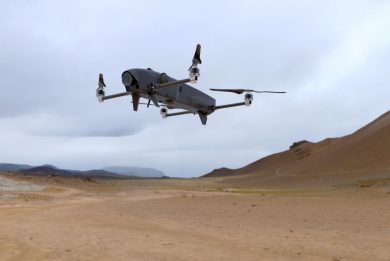
SOFINS 2023: A French Loitering Munition from the Indian Ocean
Not many companies involved in aeronautics consider rhomboidal wings. One of them is French, however it is based far away from the Hexagon, in the Reunion Island, over 9,300 km from Paris.
Here a group of engineers developed the R2-150 aircraft, a 15 kg airframe with a 1.5 meters wingspan designed for coastal and maritime surveillance applications. Shortly before SOFINS the company unveiled its R2-120 Raijin, the name coming from the Japanese god of lightning, thunder and storms, which fits it well as the new product is not made for reconnaissance but for strike, being a loitering munition. This is derived from the previously described reconnaissance UAS and has the same architecture.

According to Remy Albert, the responsible for Business Development and System Qualification at Fly-R, the rhomboidal wing has a number of advantages the first one being the shorter wingspan for the same lift, its length being slightly more than a half that of a traditional wing. Its closed configuration reduces wingtip vortex, thus lowering drag, hence an increased effectiveness, as well as a nearly constant lift to drag ratio. The high load ensures good manoeuvrability, a key factor in the last phase of the flight. It also allows a wide speed range, stall speed being 70 km/h while maximum attack speed in diving attitude reaches 270 km/h, cruise speed being 110 km/h. Propulsion is provided by an electric motor fitted at the rear driving a two foldable blade propeller. Also mass is affected by the wing architecture, estimates putting weight-saving at around one third. This might be even more considering that the rhomboidal wing is characterized by the shape of diamond on the 3 axis, therefore no vertical control surface is needed, a further contribution to weight and drag reduction. The Raijin is launched from a square-section container in which it fits thanks to its folding wings.
Upper wings are folded forward while lower wings are folded backwards, and once deployed they meet at the extremities closing the wing-box. Launch is ensured by a pneumatic system that allows reaching a 95 km/h speed before the propeller starts providing its thrust and accelerating it up to the cruise speed. When folded the R2-120 Raijin is 250 mm wide, 255 mm high and 1,195 mm long; when it leaves the launch container and deploys its wings these reach a 1,215 mm span, height being reduced to 225 mm and length to 1,070 mm. The munition follows a programme path reaching the waypoints, the bi-directional data-link allowing the operator to modify the route for operational or other reasons. A front camera provides him with a clear view; this is considered integral part of the Raijin, hence it does not impact the 1.5 kg payload. The last phase of the flight can be guided by the operator or carried out automatically, once the operator positively identified the target. Fly-R is talking to more than one provider in order to give its customers a choice of warheads to be installed on its loitering munition.
According to Remy Albert the design of the R2-120 is based 99% on that of the R2-350, and this entails that its full development will encompass a very low risk. Looking for a customer to launch full development.
Back to our SOFINS 2023 full editorial coverage menu.
Images courtesy Fly-R



